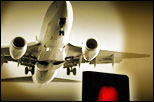Air IT system cuts plane safety distance

The plane outside the cabin window could get a lot closer, with the development of new air traffic management systems under the European Clean Sky project.

Clean Sky is a 1.6 billion euro European research project which aims to reduce European air traffic's emissions of carbon dioxide, nitrous oxides and noise by 20 to 40 percent by the year 2020.
The money will fund many different areas of research including new systems which will plan intelligent, fuel efficient flight trajectories.
The trajectory project will define "optimum" flight paths for take off and landing to achieve minimal environmental impact, taking into account atmospheric conditions. Flight paths will be optimised for each individual aircraft and new on board systems will be developed to enable the aircraft to follow them.
The systems use aircraft performance databases which aim to find the best flight path taking noise, emissions, fuel and time into account.
Aircraft flying with these air traffic management functions will need onboard systems supporting 4D trajectory flights and communications systems with broadband connectivity to transfer data between the aircraft and the ground, according to Clean Sky member company SAAB.
In addition to reducing fuel consumption and emissions, the traffic management systems will increase air traffic density by reducing the safety distance between aircraft, according to SAAB, because air traffic controllers will know at all times where the aircraft are, and will be able to give planes their landing slot time quicker.
Scandinavian Airlines has already demonstrated part of the trajectory optimisation program, clocking up over 2000 advanced continuous descent approaches with a Boeing 737. Each controlled 737 approach saved approximately 150 kilos of fuel and 470 kilos of carbon dioxide.